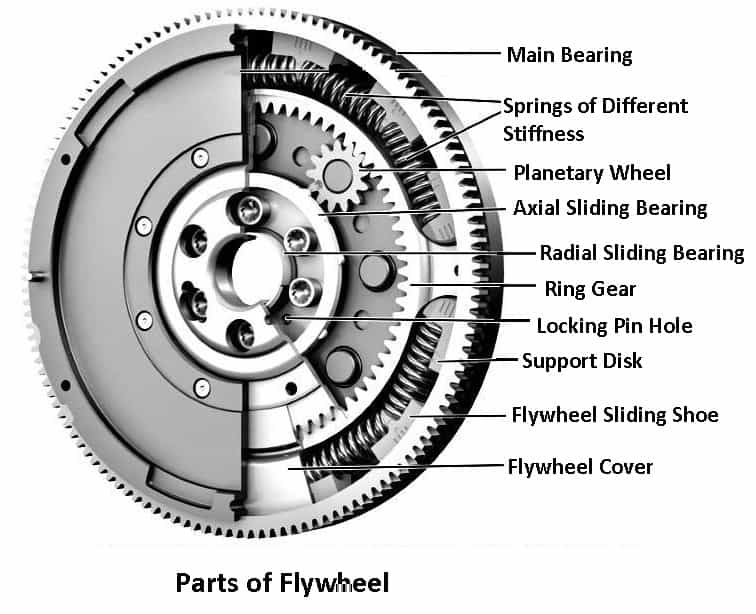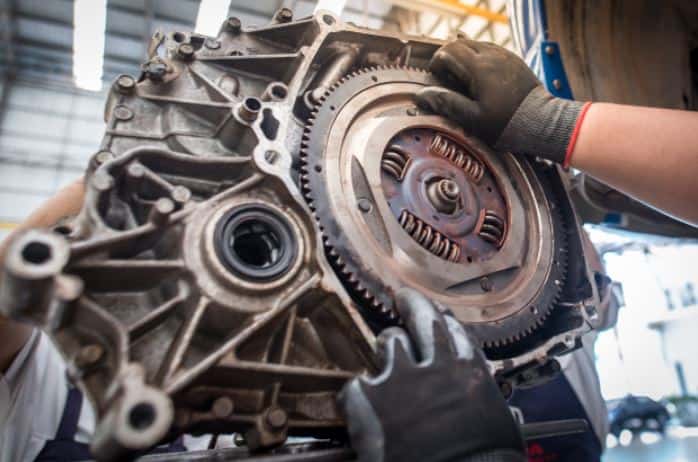In this article, you’ll learn what is a flywheel? How it works? its parts, function, and types of the flywheel. Explained in detail with diagrams and also download the pdf file of this article at the end of it.
Flywheel and Types
What is flywheel?
A flywheel is a fairly heavy steel wheel that is attached to the rear end of the crankshaft. The size of the flywheel is depended upon the number of cylinders and the construction of the engine.
The flow of power from the engine cylinders isn’t smooth. Although, the power impulses in a multi-cylinder engine overlap each other to provide a fairly even flow of power. However, additional leveling off of power impulses is required. This is done by a flywheel.
Parts of Flywheel
Following are the parts of a flywheel:
- Flywheel housing
- Springs
- Planetary wheel
- Axial sliding bearing
- Radial sliding bearing
- Ring gear
- Locking pinhole
- Support disk
- Flywheel sliding shoe
- Flywheel cover

1. Flywheel Housing
The flywheel housing is solid and sits outside of the flywheel. The flywheel is the part of the engine that rotates and delivers power to the alternator.
2. Springs
The flywheel is consists of two-phase bent springs in parallel. The outer arc is adjusted to raise the spring when the engine is operating. The soft outer arc spring only serves to improve the uncertain resonance frequency range.
3. Planetary Wheel
A planetary wheel consists of many planetary gears fixed on a flywheel bracket. When the flywheel bracket is operated by a screw and rotates, the meshing with the outer ring gear produces a compound motion composed of each planetary gear revolution and rotation.
4. Axial and Radial Sliding Bearing
While the axially acting bearing serves only for weight compensation, the imbalance or parasitic radial forces initiated by the motor or generator unit must be compensated by
radial Bearings.
5. Ring Gear
A ring gear is fitted to the outer diameter of the flywheel. It is usually fixed to the flywheel with the help of an interference fit, which is produced by heating the ring gear. So, the thermal expansion enables it to be placed around the flywheel.
6. Support Disc
As the name suggests, the support disc is attached inside the flywheel to support the two-phase bent springs and other components of the flywheel.
7. Flywheel Sliding Shoe
Sliding shoes preferably have a convex radial outer portion bearing on the inner wall of the flywheel. In this area, they are preferably manufactured to promote slip and suffer minimal wear and tear.
8. Flywheel Cover
The flywheel cover is commonly made of chrome. This chrome-plated flywheel cover will prevent dust from getting into the internal functions of the flywheel, due to which it is running poorly.
Functions of Flywheel
To understand how a flywheel works in a better way, take the example of a four-stroke, single-cylinder engine. There are occasions when more power is being produced than at other times. This tends to make a crankshaft speed up and then slow down.

The engine delivers power only during the power stroke. It absorbs power during the other three strokes to eject exhaust gases, take fresh charge into the cylinder, and compress this charge.
Thus, during the power stroke, the engine tends to speed up and during the other three strokes, it tends to slow down. The inertia of the flywheel tends to keep it running at a constant speed. When the engine tends to speed up the flywheel resists it.
The flywheel resists when the engine tends to slow down. Thus, the flywheel absorbs energy as the engine tries to accelerate and gives back as the engine tries to slow down, keeping the engine speed almost constant.
In a multi-cylinder engine, the flywheel acts, in the same way, to smooth out still more the peaks and valleys of power flow from the engine.
The flywheel is also used as a part of the clutch mechanism and fluid drive unit. The outer edge of the flywheel has forged teeth to mesh with the electric cranking motor-driven pinion when the engine is being cranked to start it.
Types of Flywheel
Following are the types of flywheel used in vehicle:
- Solid disc flywheel
- Rimmed flywheel
- High-velocity flywheel
- Low-velocity flywheel
1. Solid Disc Flywheel
The Solid disc flywheel is a type of flywheel. It is used in a single flywheel thresher is made of cast iron. The solid disc flywheel is equipped with a flywheel hub and disc.
In the design calculation of a solid disk flywheel, various parameters are used as inputs. This includes the dimensions of the solid disk flywheel. Also, resulting functional values are calculated.
2. Rimmed Flywheel
The rim-type flywheel will explode at a much lower rotary speed than a solid disc-type wheel of equal weight and diameter. For minimal weight and high energy-storage capacity, a flywheel can be formed of high-strength steel and produced as a tapered disk, which is thick in the center.
3. High Velocity Flywheel
In these types of the flywheel, the high-velocity flywheel has a velocity between 30000 rpm to 80000 rpm. That can also be adjusted up to 100,000 rpm.
They have magnetic levitation bearings and require little maintenance. These are light in weight when compared to a low-velocity flywheel according to size/capacity. They are more expensive than a low-velocity flywheel.
4. Low Velocity Flywheel
In these types of the flywheel, the low-velocity flywheel has a velocity of 10000 rpm. They are heavier and bulky than the high-velocity flywheels.
They require time to time maintenance and do not use magnetic levitation bearings. Their installation requires special concrete construction to carry its weight. They are more affordable than high-velocity flywheels.
Materials Use To Make Flywheel
The flywheel is made from many different materials depending on their applications. Cast iron flywheel is used in older steam locomotives. The flywheels used in the car’s engine are usually built of cast or nodular iron, steel, or aluminum.
Flywheels also made of high-strength steel. The composite flywheel is meant for use in vehicle energy storage and braking systems. The power of a flywheel is determined by the maximum amount of energy that it can store per unit load.
Common Problems of Flywheel
Following are the faults that occur when a flywheel is defective:
- Clutch dragging
- Clutch slipping
- Burning smell
- Clutch chatter
- Clutch pedal vibration
1. Clutch Dragging
In this case, the clutch will not release completely. This will cause different levels of gear grinding when changing gears.
Moreover, it can completely fail to put the car in first gear when it starts at a standstill. This problem is not only made in the flywheel but in the flywheel or crankshaft assembly bearing or bushing.
2. Clutch Slipping
This problem occurs when the gears automatically change while driving. Due to it, the gear may slip. This happens when power is not transferred to the wheels, resulting in a clutch failure.
The slipping clutch will eventually degrade the flywheel as well. The pressure plate may cause a sudden grinding sound. Other parts of the flywheel in the clutch assembly will heat up. This will lead to bends and even cracks.
3. Burning Smell
When the clutch goes bad, a burning smell will produce. This is caused by a faulty flywheel or an unskilled operator.
The face of the clutch is designed with materials proposed to decrease the amount of sound the clutch makes while working. This produces too much heat due to friction when the facing is not properly operated.
4. Clutch Chatter
This occurs when the clutch has difficulty engaging. As the clutch catches, it slips along the flywheel and leaves the flywheel repeatedly. On release, it seems like stutter or vibration.
Clutch chattering is often in any gear when starting with a full stop. This fault can be difficult to recognize because there is a defect in the clutch disc, pressure plate, or release bearings. These parts can also be broken, deformed, or contaminated with oil.
5. Clutch Pedal Vibration
You may have noticed that the clutch pedal or vehicle floor is vibrating when the flywheel is damaged. This is because the spring mounts of the flywheel have declined. Let us tell you that the spring mechanism reduces the vibration caused by the clutch being used.
Applications of Flywheel
Its purpose is to smooth the power generation of an energy source. Take an example, the flywheel is used in reciprocating engines because the active torque from the individual pistons is broken.
Flywheel is usually applied in energy storage systems to maintain the energy in the system as rotational energy.
Providing energy at rates higher than the capacity of the energy source. This is done by getting energy in a flywheel over time. Then releasing it quickly at rates that exceed the energy source’s capabilities.
It is useful in controlling the adjustment of a mechanical system, gyroscope, and reaction cycle. Flywheel is used with a motorized generator to store energy. Most of the time flywheel is used in wind turbines and automobile vehicle engines.
Used in electric cars to boost the speed and in large power grids for protection from blockages. Moreover, the flywheel is employed in advanced locomotive propulsion systems and in technology transportation buses.
Advantages and Disadvantages of Flywheel
Advantages
- The overall cost of the flywheel is less.
- They have a greater lifespan.
- By using flywheel can provide you greater storage capacity.
- It requires less maintenance and has a lesser thermal loss.
- Flywheel is safe, reliable, and energy-efficient.
- It is easy to operate and requires high energy density.
Disadvantages
- The main drawback of the flywheel is that it requires a lot of space.
- They are quite expensive to manufacture.
- Building materials always have a limit for.
Wrapping it up
The flywheel is an important part of the engine. Without a flywheel, the engine loses part of the speed that continues the crankshaft speed, so it is needed. Now, I hope that you have learned about the flywheel and its different parts and types.
If you have any questions or doubts about this article, you can ask in the comments. If you liked this article, then please share it with your friends.
Subscribe to our newsletter to be notified when we upload new posts. it’s free.
Download the PDF file of this article:
Read More Engines Parts Like This:
- What are the Types of Combustion Chamber and Cylinder Head?
- What is the function of Spark Plug in an engine? Types, Parts, Working & (PDF)
Referances:
- Why flywheel is important – Carthrottle.com
- Bad flywheel symptoms – itstillruns.com
FAQ
A flywheel is a heavy steel wheel that is connected to the rear end of the crankshaft. The size of the flywheel is depended upon the number of cylinders and the construction of the engine.
To better understand how a flywheel works, take the example of a four-stroke, single-cylinder engine. There are occasions when more power is being produced than at other times. This tends to make a crankshaft speed up and then slow down.
The flywheel is mainly consists of parts such as Flywheel housing, Springs, Planetary wheel, Axial sliding bearing, Radial sliding bearing, Ring gear, Locking pinhole, Support disk, Flywheel sliding shoe and Flywheel cover.
Its purpose is to smooth the power generation of an energy source. Take an example, the flywheel is used in reciprocating engines because the actuated torque is broken down by the individual pistons.
best clarification on flywheel
Thank you so much.
I would like to get the PDF.
The PDF file has been sent to your inbox.
I would love to know more about mechanics
We have so many articles related to this topic, you can check them out as well. Thanks for reading.
I would like to know more about mechanics
You can explore our blog to learn more about mechanical engineering 😉